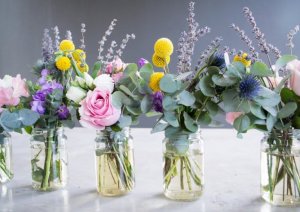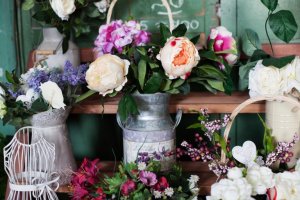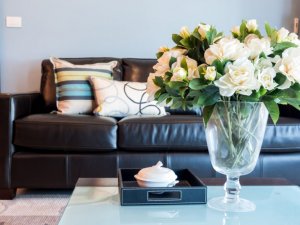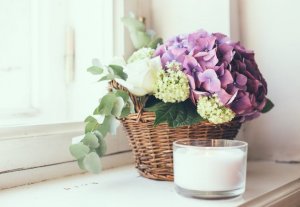Flower Arranging: Learn How to Make Beautiful Bouquets

If you want to create some beautiful flower arrangements, there are a few basic things you need to know. In the world of flower arranging, the following concepts are fundamental: balance and volume, rhythm and harmony, and color combinations.
Whether shop-bought or home-grown, when it comes to flower arranging, you need to try to create harmony between the flowers, the foliage, the vase, and the room. After all, bouquets are just like any other decorative element. Get it right, and they can be a great way to decorate your home.
Flower arranging: creating beautiful bouquets
In this section, we’ll give you some basic rules to keep in mind when creating your own bouquets.
Balance and volume

Balance is one of the most important aspects to keep in mind. Whether large or small, bouquets need to be arranged so that they work in harmony with the vase they are going to be placed in.
Don’t add more flowers to one side than the other, or place too much greenery in the center of the bouquet. Naturally, the number of flowers and greenery you add will depend on how large the container is.
Rhythm and harmony

A bouquet can be made up of just one type and color flower, or several different varieties, and may or may not be combined with greenery. In fact, if arranged well, greenery on its own can make a beautiful and elegant arrangement.
If you’re looking to create contrast, it’s best to use flowers and foliage of all different shapes and colors, so that no element goes unnoticed.
Alternatively, using the same type and the same color of flower throughout the bouquet and combining it with a single type of foliage will give the arrangement a real sense of character and rhythm.
Flower arranging: where to start?

The best way to give your bouquet more shape is to determine a focal point. This is the point from which all your flowers will radiate. This technique works when arranging both individual flowers and groups.
There are many different ways to arrange flowers. But whether you decide to use just one type of flower, or go for a more complex bouquet, there are some basic arrangements you should keep in mind, such as circular, fan, horizontal or vertical.
It’s usually best to place long-stem flowers in the center of the bouquet. However, by placing flowers to the outside of the arrangement, you can actually create more than one focal point. This method also works well if you’re creating greenery bouquets.
Arrangement

Irregularly shaped flowers such as chrysanthemums and lilies should be placed in the center of the arrangement. By placing them here, these large flowers are less likely to eclipse the rest of the flowers in the bouquet.
Small round flowers such as carnations should be placed toward the top of the bouquet so that they sit higher than large flowers such as dahlias. That way, they don’t get lost among the larger flowers.
Hanging flowers, such as wisteria and willow, should be left with long stems so that they can hang down from the top of the bouquet. This will help create a really beautiful and dynamic look.
Creating the perfect color combinations

Before choosing the colors for your bouquet, you need to think about where you’re going to display your flowers, taking into account the furniture, and other elements. The background you display them on will play an important role in the overall effect they will have.
If you want your bouquet to be the focal point of your room, you have to create contrast. Alternatively, if you want them to blend into your decor, you need to use colors that match the color pallet of your walls and furniture.
If you don’t have much experience when it comes to flower arranging, start by creating simple bouquets, using one or two different flowers and some complementary foliage.
Flower arranging: color combinations

- Blues: light, intense blue flowers such as irises and hyacinths contrast beautifully with white lilies. They also work well with light purples and pinks (such as gladiola and roses) which really bring bouquets to life.
- Yellow: yellows work great with red flowers. These warm, intense colors can be found in flowers like tulips, carnations, and gerberas. They’re perfect for creating eye-catching arrangements.
- White: whether on their own or combined with pastel colors, white flowers are the perfect way to create a stunning bouquet. Tuberoses, freesias, and dahlias are some of our favorites. Plus, if you’re looking for pastel tones, orchids come in a huge variety of colors.
- Green: greenery is the ideal accompaniment for any bouquet, combining perfectly with flowers of any color.
If you want to create some beautiful flower arrangements, there are a few basic things you need to know. In the world of flower arranging, the following concepts are fundamental: balance and volume, rhythm and harmony, and color combinations.
Whether shop-bought or home-grown, when it comes to flower arranging, you need to try to create harmony between the flowers, the foliage, the vase, and the room. After all, bouquets are just like any other decorative element. Get it right, and they can be a great way to decorate your home.
Flower arranging: creating beautiful bouquets
In this section, we’ll give you some basic rules to keep in mind when creating your own bouquets.
Balance and volume

Balance is one of the most important aspects to keep in mind. Whether large or small, bouquets need to be arranged so that they work in harmony with the vase they are going to be placed in.
Don’t add more flowers to one side than the other, or place too much greenery in the center of the bouquet. Naturally, the number of flowers and greenery you add will depend on how large the container is.
Rhythm and harmony

A bouquet can be made up of just one type and color flower, or several different varieties, and may or may not be combined with greenery. In fact, if arranged well, greenery on its own can make a beautiful and elegant arrangement.
If you’re looking to create contrast, it’s best to use flowers and foliage of all different shapes and colors, so that no element goes unnoticed.
Alternatively, using the same type and the same color of flower throughout the bouquet and combining it with a single type of foliage will give the arrangement a real sense of character and rhythm.
Flower arranging: where to start?

The best way to give your bouquet more shape is to determine a focal point. This is the point from which all your flowers will radiate. This technique works when arranging both individual flowers and groups.
There are many different ways to arrange flowers. But whether you decide to use just one type of flower, or go for a more complex bouquet, there are some basic arrangements you should keep in mind, such as circular, fan, horizontal or vertical.
It’s usually best to place long-stem flowers in the center of the bouquet. However, by placing flowers to the outside of the arrangement, you can actually create more than one focal point. This method also works well if you’re creating greenery bouquets.
Arrangement

Irregularly shaped flowers such as chrysanthemums and lilies should be placed in the center of the arrangement. By placing them here, these large flowers are less likely to eclipse the rest of the flowers in the bouquet.
Small round flowers such as carnations should be placed toward the top of the bouquet so that they sit higher than large flowers such as dahlias. That way, they don’t get lost among the larger flowers.
Hanging flowers, such as wisteria and willow, should be left with long stems so that they can hang down from the top of the bouquet. This will help create a really beautiful and dynamic look.
Creating the perfect color combinations

Before choosing the colors for your bouquet, you need to think about where you’re going to display your flowers, taking into account the furniture, and other elements. The background you display them on will play an important role in the overall effect they will have.
If you want your bouquet to be the focal point of your room, you have to create contrast. Alternatively, if you want them to blend into your decor, you need to use colors that match the color pallet of your walls and furniture.
If you don’t have much experience when it comes to flower arranging, start by creating simple bouquets, using one or two different flowers and some complementary foliage.
Flower arranging: color combinations

- Blues: light, intense blue flowers such as irises and hyacinths contrast beautifully with white lilies. They also work well with light purples and pinks (such as gladiola and roses) which really bring bouquets to life.
- Yellow: yellows work great with red flowers. These warm, intense colors can be found in flowers like tulips, carnations, and gerberas. They’re perfect for creating eye-catching arrangements.
- White: whether on their own or combined with pastel colors, white flowers are the perfect way to create a stunning bouquet. Tuberoses, freesias, and dahlias are some of our favorites. Plus, if you’re looking for pastel tones, orchids come in a huge variety of colors.
- Green: greenery is the ideal accompaniment for any bouquet, combining perfectly with flowers of any color.







